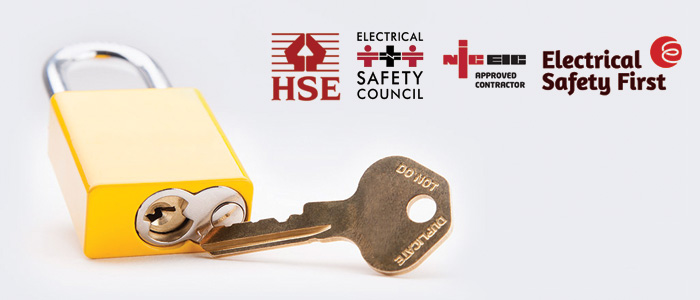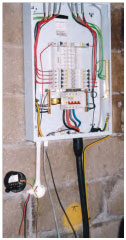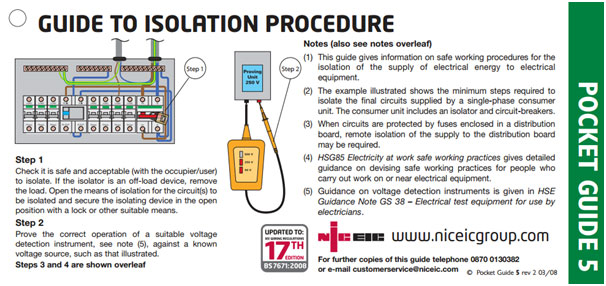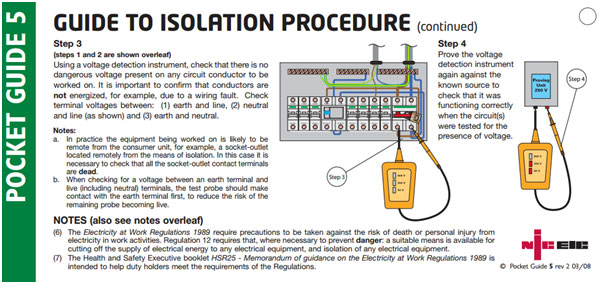
Why do we carry out safe isolation?
Safe isolation has long been a procedure carried out by a competent person in order to safely isolate electrical circuits or equipment before electrical work is undertaken. Despite this, every year people within the construction industry suffer electrical shock and serious burns of which some are sadly fatal.
Below is an excerpt from the Electrical Safety First's Best Practice Guide 2 - 'Guidance on the management of electrical safety and safe isolation procedures for low voltage installations':

An electrician working on a new-build construction project installed the three-phase and neutral distribution board shown in the photograph. He energised the supply to the distribution board before the circuits connected to it were complete, to provide a supply to a socket-outlet. He was connecting the supply cables to a wall-mounted timer unit, with the line conductor connected to the circuit-breaker at the top left hand side of the busbar assembly. The circuit-breaker had not been securely isolated and was ON as he stripped the insulation from the end of the cable. He touched the live copper conductor of the cable and was electrocuted. The distribution board was manufactured to a high standard of safety. However, if he needed to energise the board before it was complete, he should first have replaced the cover and switched off and locked the circuit-breakers supplying unfinished or incomplete circuits. He should also have ensured that circuits were not connected into circuit breakers until they were complete and had been tested.
Many accidents are consequent due to a lack of safe isolation procedures in place, or by safe isolation procedures being carried out incorrectly on low voltage electrical installations. For this reason, it is imperative to have a safe isolation procedure documented and set in place.
Method of Safe Isolation
Below is a copy of the NICEIC's 'Pocket Guide 5', which is a concise and very clear guide which can be utilised in order to carry out the isolation procedure safely:


Equipment used to safely isolate
In order to comply to HSE guidelines and to carry out safe isolation correctly, a lock and unique key, warning sign(s), an approved 2 pole voltage detector and proving unit must be used to carry out the procedures detailed in the NICEIC's 'Pocket Guide 5'. The following guidelines have been extracted from the HSE 'Electricity at work – Safe working practices HSG (Third Edition) Published 2013'.
Switches, including circuit -breakers, should be locked in the OFF position preferably using a 'safety' lock, i.e., a lock or padlock having a unique key or combination. Lockout devices that can be attached to the actuators of circuit breakers are available and should be used where appropriate. All keys should be retained in a secure place.
You should put a notice or label at the place of disconnection so everyone else knows that work is being done. For example, a 'caution' notice can be used to indicate that someone is working on the apparatus and may be injured if it is re-energised, and 'danger' notices attached to live equipment adjacent to the place of work will indicate that the apparatus is still energised.
The instrument to do this should be properly constructed to protect against electric shock and designed to prevent short circuits occurring during use. For low voltages, proprietary voltage detectors such as two-pole voltage detectors, test lamps, or voltmeters with insulated probes and fused leads can be used (see HSE Guidance Note GS38). The use of multimeters, which can be set to the wrong function, is not recommended for proving dead on low-voltage systems, neither is the use of non-contact devices such as ‘volt sticks’ (note: in coal mines the use of appropriately certified non-contact devices is permitted).
It will be necessary to test the instrument before and after use. This may be done by means of a proving unit with a low power output. If live circuits are used to prove instruments, adequate precautions against electric shock and short circuits should be taken (see paragraphs 25–32). Training in the correct use of voltage detectors is essential to avoid risk in the event of unexpected use on a live conductor. All instruments used for checking circuits should be maintained and inspected frequently (note: in coal mines appropriately certified non-contact devices must be tested daily before they are taken underground).
Test-meter.co.uk supply a 17th Edition Safe Isolation test kit which comprises the equipment detailed above in order to comply with HSE guidelines. The kit includes:
- 1 x Martindale VI13700/2 2 Pole Voltage Detector
- 1 x Martindale PD440 Proving Unit
- 1 x 38mm Safety Padlock (Supplied with 1 x Unique Key)
- 2 x Grip tight MCB Lockouts (Main Circuit Breaker)
- 2 x Mini Circuit Breaker Lockouts (11mm)
- 2 x 25mm Safety Lockout ID Tags
- 1 x 25mm Steel lockout Hasp
- Carry case for the above
If you have any questions regarding the safe isolation procedure or the equipment in order to carry out safe isolation, please feel free to call one of our trained advisors or electricians on 01132 48 99 66.
